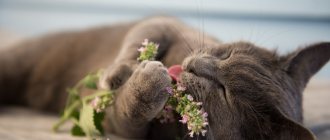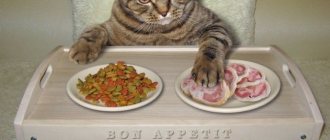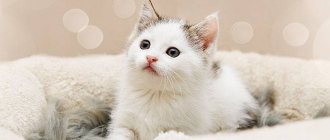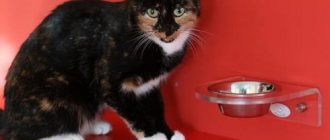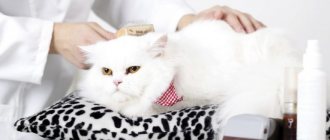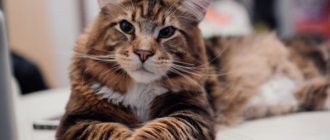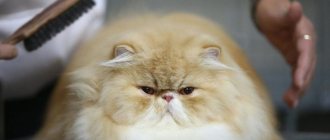Valerian officinalis is a plant with a centuries-old history of use in pharmacology, herbal medicine, folk and official medicine. According to one version, the plant received its name in honor of the Roman physician Pliny Valerian, who discovered the sedative and other medicinal properties of the root extract. According to another, the name comes from the Latin word “valere” - to be healthy, strong, to have the opportunity. Valerian for cats is not a medicine at all. Its vapors act like alcohol, causing inappropriate behavior.
How does valerian work?
Before Pliny, this herbaceous plant was used only in perfumery. Cleopatra considered valerian an aphrodisiac and placed the plant's flowers around her love bed. In Ancient Rome, Egypt, and India, tincture of the roots was used against hysteria. But cats have a completely different physiology, and the plant, which has a calming, sedative, choleretic, anticonvulsant effect on the human body, has a stimulating effect on the cat’s body. In addition, for cats, valerian is a strong narcotic and aphrodisiac.
One of the herbalists described a case when cats from all over the area came running to his beds with medicinal valerian. They dug up all the plants, rubbed their faces on the ground for a long time, rolled around, meowed wildly and even got into fights with each other. After 20 minutes, not a trace of the plant remained. But valerian does not have this effect on all cats.
The craving for valerian roots in cats is a genetically determined reaction. It is not for nothing that in Rus' valerian was called “cat grass” and “miaun”. However, about 1/3 of the murki do not respond to the smell of the plant. The remaining 2/3 are divided almost in half into representatives of the cat tribe, who are in full control of the aroma of the rhizome extract and do not react so violently and do not show much dependence. Scientists still cannot say exactly what attracts pets to the plant and how it works.
The most sensitive furries after a few drops of valerian begin to:
- shake your head;
- make chewing movements;
- rub your nose, muzzle on the bottle, floor and other objects that emit aroma;
- tumble;
- jump;
- rub your whole body on the floor;
- release claws, scratch objects;
- meow heart-rendingly;
- lick fur;
- secrete copious amounts of saliva.
In addition, they experience impaired coordination of movements, the development of hallucinations, changes in the perception of the outside world and inappropriate reactions.
Some cats, after a few drops of valerian tincture, begin to behave very cautiously, are frightened by any rustle or movement, and hide in tight, dark corners. The hallucinogenic effect of the tincture causes aggression. The cat feels like it is being chased and attacked. In this state, a cute and obedient pet becomes aggressive, attacks its owners, tears furniture and curtains, trying to climb higher.
This behavior is very similar to a person’s reaction to alcohol and drugs. The effect of valerian on the central nervous system of a cat causes euphoria, excitement, loss of coordination, aggressiveness and then depression, accompanied by apathy and deep sleep.
The danger of valerian for cats is that it is addictive and drug dependent. Veterinarians note that cats that have consumed the rhizome extract for a long time show all the signs of drug addiction:
- weight loss;
- change in the quality of wool - dullness, thinning, fragility, dryness, “disheveledness”;
- sustainable changes in behavior and character traits.
The search for “pleasure” is not unique to Homo sapiens. The animal world also has its addicts. Domestic cats go crazy for catnip (catnip) and valerian. Their wild counterparts, jaguars from South America, seek out and eat the Banisteriopsis caapi vine. The Indians call it the spirit vine for its hallucinogenic properties and ability to induce a state of euphoria. Jaguars, after chewing the leaves of the vine, roll on the ground for a while and behave like domestic cats.
Scientists admit that exposure to alkaloids sharpens sensory perception and helps big cats hunt.
In addition to the narcotic effect, valerian causes the same reaction in cats as the pheromones of an adult cat during estrus. Therefore, males react more violently to valerian. In females, the smell can cause aggression, as they perceive it as the presence of a rival.
Cat owners who want to have fun watching their pet's behavior “on valerian” should understand that they can turn their pet into a drug addict and even kill him. All the “funny” videos that owners share on the Internet demonstrate serious poisoning of cats with alcohol, which is part of the valerian tincture. What is it about the fluffy roots of the plant that has such an effect on cats?
How much valerian can you give a cat?
And yet, valerian for cats is one of the ways to relieve the animal from stress and boredom, which completely domestic pets often experience. Therefore, it is acceptable to give some crushed dry root to your cat. Manufacturers of pet accessories use this. Thus, pet stores sell toys that contain crushed valerian rhizome. Such products are considered useful because they stimulate the brain through the sense of smell, encourage the pet to act, and occupy and enrich the cat’s environment. Here it is worth considering that if there are several cats at home, then each should have its own toy. After all, even under the influence of valerian, cats do not want to share theirs. And what’s more, they can get involved in a fight to protect their “prize.”
Toys are sold, for example, in the shape of a fish with valerian root hidden in its head and catnip in its tail. By purchasing such a toy, you can understand which grass the cat has a greater weakness for.
Composition and mechanism of action
Valerian officinalis root extract includes:
- essential oil – 0.5-2%;
- free valeric acid;
- mono- and sesquiterpenes - borneol, bornyl acetate, valeranone, valerenal, valerinyl acetate;
- alkaloids – actinidine, pyrrolidone;
- esters of organic acids - butyric, acetic, formic (more than 20%);
- tannins;
- resins;
- saponins;
- Sahara;
- glycosides, including valeride;
- valepotriates.
More than 150 chemical compounds have been isolated from the rhizomes of the plant, most of which are bioactive.
Valeric acid, which is part of the extract, interacts with GABAA receptors located in the central nervous system, muscles, motor part of the brain, and cochlea of the inner ear. They bind psychotropic substances (barbiturates), ethanol, and neurosteroids.
Ethyl alcohol, which is part of the tincture, causes very rapid intoxication, intoxication and alcohol dependence in cats. In addition, valeric acid causes muscle relaxation and impaired coordination of movements. The effect is similar to the effect of barbiturates, which cause addiction and drug dependence.
The active components of valerian affect the automatism and conduction system of the heart. In cats, the heart rate increases and blood pressure rises. In humans, the opposite effect occurs. Over time, the indicators drop and the cat becomes lethargic.
Actinidin, which is part of the essential oil of the plant, causes sexual arousal in cats, as its smell is similar to the pheromones released by a cat during estrus. A similar effect is caused by catnip nepetalactone.
The difficulty in establishing the mechanism of action of valerian is that almost all substances have a bioactive effect. Many compounds have a wide spectrum of action and enhance each other's chemistry.
Experiments with valerian
Many owners let their cats smell valerian for fun. They are interested in observing sudden changes in behavior in a cat. But after a sudden surge of energy, the animal experiences a loss of strength, drowsiness and lethargy. The cat can simply fall asleep for several hours. It is also not recommended to repeat such experiments several times in a row. Because it can be addictive. Just like a person after drinking alcohol, a cat can subsequently experience real withdrawal symptoms. This aroma has a particularly alluring effect on males.
According to one version of scientists, the smell of valerian attracts them in the same way as the fluids of individuals of the opposite sex. Since experiments were carried out and valerian was given to kittens who had not yet reached four months of age to smell, their behavior did not change at all. And after the animal reaches puberty, it begins to react to such an alluring aroma. The animal simply begins to experience sexual arousal towards the opposite sex.
Consequences of overdose
The effect of valerian officinalis preparations depends on the dose. A large amount of valerian causes intoxication of the body, overstimulation of the central nervous system and is accompanied by:
- convulsions;
- foam from the mouth;
- dilated pupils of the eyes;
- difficulty breathing, even stopping;
- a sharp increase in pressure, increased heartbeat, which can lead to heart attack and stroke;
- signs of burns to the oral mucosa or intestines, which causes the formation of ulcers;
- defecation disorder - diarrhea;
- muscle atony.
Severe intoxication can lead to the death of the animal and for assistance you must immediately contact a veterinary clinic.
Trying to save a cat on your own is not recommended - you will miss the time necessary for detoxification and maintaining the functions of the respiratory and cardiovascular systems.
Valerian overdose: main symptoms
As soon as your pet gets to the package of tablets or tincture, he, without knowing the measures, will destroy it all in an instant. In this case, an overdose of the drug occurs, and this cannot be done without the intervention of a veterinarian, otherwise the animal’s life will be at risk.
Signs of an overdose include the following:
- the cat constantly falls on its side;
- she is seized by convulsions;
- white foam coming from the mouth;
- eyes roll involuntarily.
Photo: https://drugbarsuk.ru/wp-content/uploads/2018/10/posledstviya-1024×677.jpg
We must not forget that valerian is a very dangerous remedy for cats. It can only be used as prescribed by a veterinarian and only under his supervision, because pets tolerate the effects of this drug differently.
Can the product be used for medicinal purposes?
Veterinarians do not recommend treating a cat with valerian. Any medicine must be prescribed by a specialist. In some cases, doctors advise giving a few drops of valerian to animals with lack of appetite, depression, and apathy. The medicine will have a stimulating effect, but only if the veterinarian’s instructions are strictly followed.
A safer alternative to valerian is catnip or catnip. Its bioactive substances do not cause addiction or side effects. A few mint leaves will help your cat cope with stress from visiting the veterinary clinic, moving, or performing at an exhibition.
Some people advise training cats to use a scratching post or litter box with the help of valerian. But there are special products that contain the essential oil of the plant. They are safer than tincture.
Dry catnip herb is placed in toys and pillows to improve cat sleep. But the use of plants that are attractive to the cat breed must be coordinated with a specialist so as not to cause pathological nervous inhibition and “burnout” of nerve receptors.
Dosage
Is it possible to give cats valerian and how many drops? As we found out, in certain cases it is possible and necessary. But the main thing here is not to overdo it with the dosage.
You can put a couple of drops, no more, on her nose, or dilute it in a small amount of water and try to let her drink it. The main thing is to remember that valerian, like any medicine, can either help or harm your pet. But is it possible to give a cat valerian tablets? It's worth thinking about here. Whether as a sedative or stimulant, the tablet form of the drug will not bring any results. Therefore, do not torture the animal again.
Which cats do not react to the plant?
About 30% of domestic cats do not react at all to the smell of valerian.
Scientists have found that an autosomal gene is responsible for the genetic predilection for the plant. Its mutation causes a lack of response to valerian. Kittens under 6 weeks of age also do not respond to cat drugs. They have not yet developed a hormonal system and lack sexual desire, which is stimulated by sex pheromones.
Most females do not react to the smell of valerian, as it resembles the pheromone of an individual of the same sex as the cat. Some breeds of cats completely ignore valerian. In particular, Siamese cats are immune to the calling scent.
The reaction also depends on the individual characteristics of the animal. In some cats, valerian causes disgust, fear, and a desire to get away from the source of the smell faster and further. This reaction is probably caused not only by the gene, but also by the state of the nervous system, character, and temperament of the pet.
Also watch the video why cats love valerian:
What happens to a cat who takes a dose of valerian?
A few minutes after taking the “exciting medicine,” a calm domestic cat turns into a restless bully. Each cat's behavior may vary. But don’t be surprised to see your four-legged furry howling, endlessly rolling on the floor, greedily tearing curtains and wallpaper, and also peeing in the corners.
Valerian is a drug for cats. It can provoke various hallucinations in the animal. The cat can attack an imaginary enemy or run away from a predator pursuing it.
